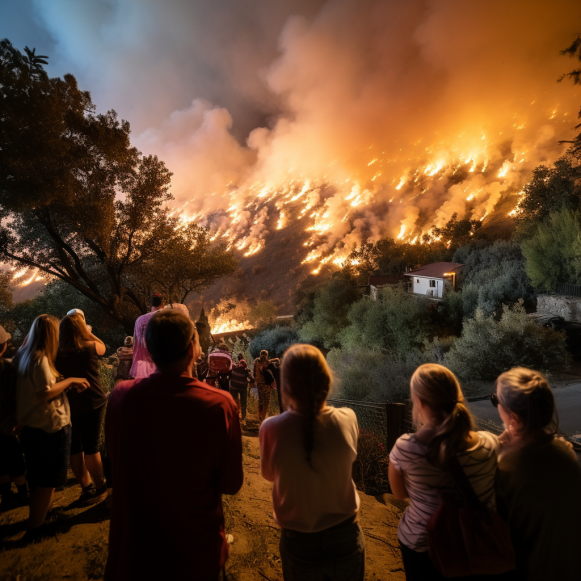Insurance premiums could surge in these U.S. cities because of climate disasters, new data shows

According to new data, millions of American homeowners’ insurance rates may rise in the coming years, owing in part to worsening climate disasters.
According to a study conducted by the nonprofit research group First Street Foundation, nearly 39 million homes and commercial properties – roughly 27% of properties in the Lower 48 – are at risk of having their premiums raised as insurers struggle to cover the rising cost of rebuilding after disasters.
It’s yet another worrying sign for the future of the homeowners’ insurance market in the United States. In recent years, major insurers have withdrawn from or ceased writing new policies in California, Florida, and Louisiana, citing increased climate risks such as more destructive wildfires and stronger hurricanes.
However, while insurance prices have already risen in those states, First Street discovered that they are still rising in places we consider to be less risky.
“This is not just isolated to particular areas of the country, but will also impact other areas that we might not traditionally think of,” said David Jones, former California insurance commissioner and director of the Climate Risk Initiative at UC Berkeley’s Center for Law, Energy, and the Environment, who was not involved in the analysis.
According to Jeremy Porter, the head of climate implications at First Street and one of the report’s lead authors, the insurance industry is only now beginning to price the cost of climate change into premiums.
“We’re still kind of at the forefront of the insurance industry when it comes to pricing in climate risk into the real estate market,” Porter told CNN. “Insurance companies will continue to respond to increasing climate damage.”
This also means fewer options for homeowners as private insurers withdraw from high-risk areas or limit coverage.
According to First Street, nearly 7 million properties, or nearly one in every twenty buildings, have already experienced price increases or have been dropped by insurance companies. The majority of those properties are in California, which is prone to wildfires and flooding, or in hurricane-prone Florida, Louisiana, and Texas.
However, this issue is spreading across the country. Jones cited recent extreme flooding in Vermont this summer, which dumped up to 9 inches in some areas of the state over two days and submerged the state capital of Montpelier. Massive rainstorms combined with steep terrain to overwhelm small streams and creeks in Kentucky and West Virginia, resulting in deadly and costly flooding.
“It’s difficult to identify a region of the country that hasn’t been impacted or will not be impacted,” Jones told CNN. “And it’s only going to get worse.”
Rising premiums
According to a First Street data analysis, every property in more than one in ten American cities is at risk of premium increases due to climate disasters. These include areas in states where insurers have already begun to withdraw, such as Miami, Jacksonville, and New Orleans.
Outside of California, Florida, and Louisiana, the data shows that there are cities where all properties are vulnerable to price changes, primarily along the East Coast where hurricane risk is high and sea level is rising, such as Atlantic City, New Jersey; Virginia Beach and Norfolk, Virginia; Wilmington, North Carolina; Charleston, South Carolina; and Savannah, Georgia.
According to First Street data, premiums are on the verge of rising to a lesser extent in cities across the country.
Rate hikes threaten properties in four out of five cities in the Lower 48, including more than 25% of properties in New York City and Phoenix. In the Midwest, up to one-fifth of homes in Chicago, Pittsburgh, Louisville, and Cincinnati are at risk of premium increases due to flooding rain and strong winds. On the West Coast, premiums could rise in nearly all of Riverside, California, and a fifth of Los Angeles.
Even if these homes are not yet covered by the state’s last-resort insurer, for which they typically pay higher premiums for a policy that covers less, “they have the same risk profile,” Porter said.
While this dynamic is just getting started in the private insurance market, price shocks have already hit homeowners enrolled in the federal government’s flood insurance program. Premiums for federal flood insurance, known as the National Flood Insurance Program, will skyrocket beginning in 2021 as the federal government adjusts for the cost of more powerful storms.
As the plan is implemented over the next several years, the most flood-prone areas of Gulf Coast states are expected to bear the brunt of rate increases; in Plaquemines Parish, Louisiana, FEMA data shows that insurance premiums would rise 545% — from $842 to $5,431 per year. In Collier County, Florida, which was hit by Hurricane Ian last year, the increase was expected to range between $1,050 and $4,000.
Consequences beyond the insurance industry
Some homeowners’ premiums have skyrocketed, and the math isn’t working for them.
“When you see this huge spike – doubling, tripling, quadrupling of your insurance rate – all of a sudden those finances don’t make sense to regular people,” he explained.
Due to higher premiums, some homeowners who do not have a mortgage are opting out of insurance entirely, leaving them unprotected if a disaster strikes, according to Amy Bach, executive director of United Policyholders, an insurance consumer advocacy group.
It’s difficult to know how many homeowners choose to “go bare” without insurance, according to Bach, because she believes many are unwilling to self-report their decision. However, her work with homeowners provides her with insight into people’s decisions.
“I know where people are dropping insurance — it’s Florida, Louisiana, California, and Colorado,” Bach told CNN. “And there will be more places soon, because this is a national virus.”
According to Jones and Porter, there will be larger economic consequences down the road when homeowners who have paid a higher premium try to sell their home and find they are out of buyers.
According to Jones, there is already evidence that a lack of affordable insurance is affecting home prices in areas of California prone to wildfires.
“It stands to reason that if you’re a homebuyer, you’ll want to know how much it’ll cost me to insure this place, and can I get insurance?” Jones stated.
If the answer is that insurance is prohibitively expensive and difficult to obtain, “then homebuyers are saying, ‘I’m not going to pay as much for this house, because it’s simply not worth as much.'”






